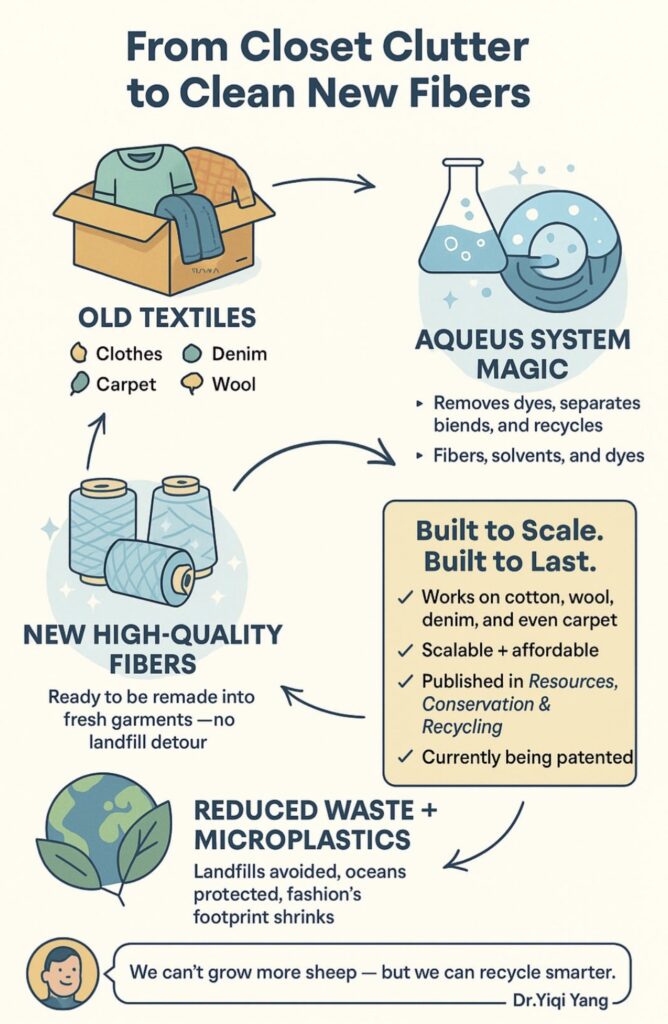Spoiler alert: Maybe. But it’s going to take more than just fancy science.
Let’s start with a little bit of hope — and some serious textile wizardry.
Turning Old Textiles into New Fibers
A team of scientists at the University of Nebraska–Lincoln, led by textile chemical engineer Yiqi Yang, developed a first-of-its-kind chemical recycling system that can turn old textiles into actually usable new fibers.
We’re not talking about shredding an old T-shirt into stuffing for dog beds. We’re talking fiber-to-fiber recycling that removes dyes, separates blended fabrics, and spits out clean, high-quality material ready for a second stylish life.
Even cooler? This isn’t just theory — Yang and his team have successfully implemented an aqueous system that recycles not only the fibers, but also the solvents and dyes, leaving practically no waste behind. Their work has been published in Resources, Conservation and Recycling, and they’re in the process of patenting the technology. It works on a wide range of fibers — from cotton and wool to carpet — and it’s built with scalability and affordability in mind. Which is music to the ears of anyone hoping to give fast fashion a sustainable reboot.
Jeans? Wool sweaters? Carpet scraps? It seems like it’s all fair game.
The best part? It’s cost-effective, scalable, and designed with mass production in mind — meaning it could keep millions of pounds of textile waste out of landfills and oceans.

This breakthrough is big, but there’s a growing global squad of researchers trying to clean up fashion’s mess. Here are some of the game-changing projects happening around the world:
Chemical Recycling Innovations
University of Delaware (USA): They’ve developed a microwave-assisted glycolysis process to chemically recycle synthetic fabrics like polyester and spandex. Translation: they’re zapping old clothes into reusable building blocks for new ones.
Aalto University (Finland): They’re working on ways to depolymerize synthetic fibers like polyester, turning them back into monomers (the building blocks of fabric), then repolymerizing them into fresh, high-quality material. It’s like rebooting fabric at the molecular level.
University of Amsterdam (Netherlands): They’ve teamed up with Avantium to separate cotton and polyester in polycotton blends. The cotton gets turned into glucose (yes, sugar!), and the polyester is recycled into usable fibers.
Enzyme-Based and Biological Recycling
Stanford University (USA): The Huminly project is engineering enzymes to break down synthetic fibers in mixed garments — a super promising solution for recycling blended fabrics, which are notoriously hard to deal with.
North Carolina State University (USA): They are exploring how enzymes can break down cotton into components that could be repurposed or reborn as new materials. Think of it as giving old cotton a whole new identity.
Mechanical and Hybrid Recycling Approaches
University of Minnesota Duluth (USA): Meet the Fiber Shredder — a mechanical device that chews up old textiles into fine fibers that can be re-spun into new yarns. No chemistry here, just good old-fashioned fiber munching.
The Hong Kong Research Institute of Textiles and Apparel (HKRITA): Their Green Machine uses hydrothermal tech (that’s hot water and pressure) to separate cotton and polyester — and it does it without using a single drop of additional water or harsh chemicals. Yes, really.
So… Can Tech Save Us?
Here’s the deal. Technology is an amazing tool — but it’s not a get-out-of-jail-free card. It’s like putting a Brita filter on a faucet that’s still spewing sludge. Necessary? Absolutely. Enough? Not quite.
Because the real problem isn’t just what we throw away — it’s how much we consume in the first place.
We can’t keep treating clothes like single-use plastic and expect tech to clean up the aftermath. Recycling blended fabrics is hard. Building infrastructure to do it at scale? Even harder.
The Real Solution to Fast Fashion Pollution
We need tech and behavior change. We need brands to step up and consumers (ahem, us) to slow down. We need fiber innovation and a little personal closet audit now and then.
Think of it this way: technology is the parachute. Fast fashion is the cliff. Wouldn’t it be better if we just… didn’t jump?
So What Can You Do?
- Buy less, wear more. Repeat outfits like it’s your superpower. Because it is.
- Support brands that actually invest in sustainability (not just green-colored hang tags).
- Resell, swap, or recycle when possible. Don’t let your clothes die in the back of a closet.
- Share these innovations — because if the industry knows we care, it’ll start to care too.
Final Stitch
From microwave chemistry to denim-eating enzymes, innovation is on our side. But at the end of the day, the fastest route to fashion sustainability isn’t a lab — it’s us, making slightly better choices, one outfit at a time.
So the next time you’re tempted by a $4 top you’ll wear once, ask yourself: Do I really need this? Or do I just need to be reminded I have style without it?
Because fashion can still be fun — without being wasteful. And thanks to the brilliant minds pushing boundaries in labs around the world, the future of fashion just might be circular.

Follow me on my socials:
- Instagram: @lexysilverstein
- Youtube: Lexy Silverstein
- Twitter: @eLEXYfy
- TikTok: @lexysilverstein
- Facebook: Lexy Silverstein
- Liketoknow.it/lexysilverstein




